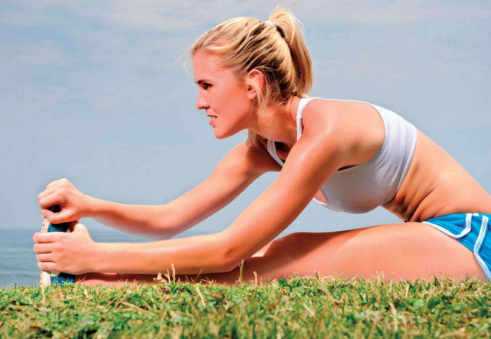Turn your body into a more efficient,
calorie-burning machine with these four strategies. Plus, transform your body
with our metabolism-boosting cardio and strength workouts
There is no secret formula that'll speed up
your metabolism. The bottom line is the more calories you burn beyond those you
consume, the more weight you will lose. But there are tricks you can try when
it comes to diet and exercise. Try these ideas.
Diet
Eat a decent breakfast that contains lean
protein, complex carbs and healthy fats. Eating first thing after you get up
raises the metabolism. One study published in the American Journal of
Epidemiology found people who got 20 percent of their total daily calories at breakfast
were half as likely to gain weight as those for whom breakfast accounted for 11
percent of their calories.

Have a black coffee. The journal Physiology
and Behaviour found that the average metabolic rate of people who drank black
coffee was 16 percent higher than those who drank decaf. But, avoid the milk
and sugar.
Eat six times a day. Vision Personal
Training tells its clients that eating six small, high protein meals a day is
worth 30 minutes of exercise. The reason? Eating regularly speeds up the
metabolism.
Exercise
Up your intensity . You can increase your
intensity by exercising harder. The average woman burns 332 calories running on
a flat treadmill for 30 minutes at 9 kmph (1,992 calories per week based on six
workouts a week). If she increases her speed to 10 kmph, she'll burn 365
calories (2,190 per week). Add a 5 percent incline and she will burn 401
calories in 30 minutes (2,406 per week). Those small changes mean 198-414 more
calories torched per week. In order to lose half a kilo, you need to cut or
burn 3,500 calories, or 500 a day. By slightly increasing your effort, you can
hit that goal faster.

Start with a plan. Plan your workout in
advance to focus on quality, not quantity. Consider this: in 30 minutes you can
walk at 5 kmph and burn 125 calories. But if you alternate between running at 5
kmph and walking at 5 kmph, devoting 15 minutes to each, you'll up your caloric
expenditure to 194 calories. By planning ahead to do intervals, you'll burn an
extra 69 calories in the same amount of time. That adds up to an extra 414
calories per week.
Choose multi-muscle moves. Do exercises
that work the upper and lower body simultaneously, like a biceps curl combined
with a step-up. The more large muscle groups you use, the more calories you
burn in the same amount of time.
Add plyometric moves. Including plyometrics
such as jumping or hopping increases your calorie burn because you're lifting
your own body weight off the floor. A 65kg woman will burn 329 calories in a
60-minute low-impact aerobic class; but make it high-impact and she'll burn 460
calories in the same time, a difference of 131 calories.
Shape's fat burning workout
Ever envied a friend's fast metabolism?
Wished you could get yours up to speed? Your single most important action in
improving how your body burns calories may be exercising more efficiently. The
more calories you expend in a 24-hour period as a result of physical activity,
the higher your metabolic rate, says metabolism expert Dixie Stanforth, of the
department of kinesiology and health education at the University of Texas in
Austin. SHAPE asked her to design a workout to maximise caloric expenditure –
in other words, to help you exercise smarter. We've also included five
metabolism-boosting tips to step up your workouts and help you burn more
calories, reduce fat and gain muscle.

The
average metabolic rate of people who drank black coffee was 16 percent higher
than those who drank decafdrank
What you will get: Cardio + strength
Degree of difficulty: Challenging
Where you do it: Anywhere
Time: 20-50 minutes
What you need: Dumbbells, Medicenball, Step
The smarter exercise plan
(Cardio + strength and cardio-only
workouts)
SCHEDULE you'll do three varied-intensity
cardio workouts and three "Challenge Circuit" (cardio + strength)
workouts per week on alternating days (see next page for instructions).
The Challenge Circuit includes three rounds
of cardio, each followed by two or three multi-muscle exercises done without
resting. The three cardio-only days should include two steady-state days and
one interval workout day. Try this sample schedule:
DAY 1 Steady-state cardio
DAY 2 Challenge circuit
DAY 3 Interval cardio
DAY 4 Challenge circuit
DAY 5 Steady-state cardio
DAY 6 Challenge circuit
DAY 7 Rest
BEGINNER Start with two days of cardio-only
(one steady-state and one interval) and two "Challenge Circuit"
workouts each week, adding more workouts as you feel ready.
WARM-UP Do six minutes total including easy
shoulder rolls and arm swings then take a brisk walk or march in place. Add
more dynamic movement by walking across the room, alternating knee lifts, torso
twists with arms extended at shoulder height in a "T" and reversing
lunges with an alternate arm punch.
COOL-DOWN Stretch all the major muscle
groups, holding each stretch for 30 seconds without bouncing.

The smarter exercise plan